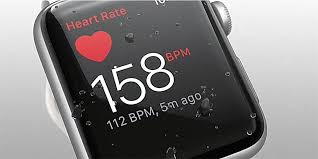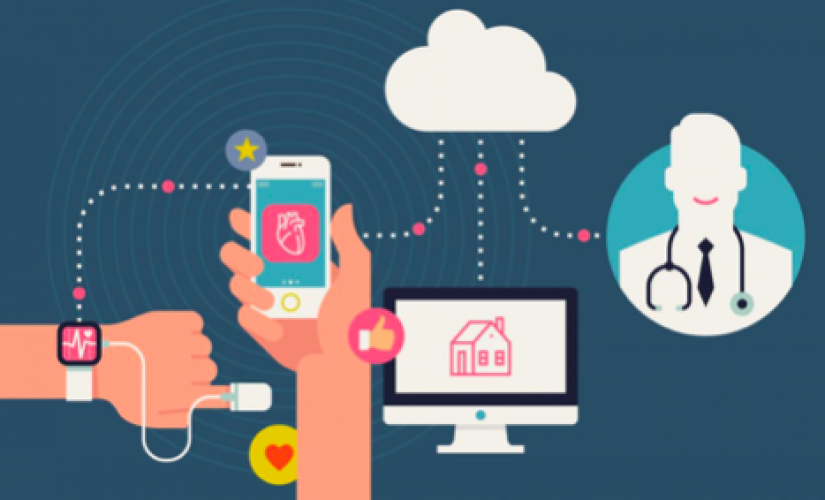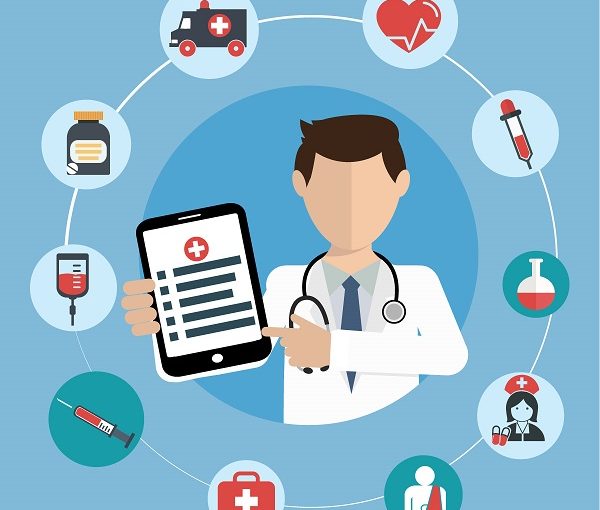Ethical Issues of the Healthcare Internet of Things
By Osmar Coronel | October 21, 2018
 Tracking vital signs on the fly
Tracking vital signs on the fly
Very likely you are already using an Internet of Things
(IoTs) product for your healthcare.
 Our new connected world
Our new connected world
IoTs are small computing objects that are constantly collecting information and sending it to the cloud or turning on or off something automatically. This blog is mainly focused on the ethical risks of IoT devices applied to improving your health.
IoT devices are predicted to expand in the healthcare industry due to the many benefits they provide. However, our FIPP, Fair Information Practice Policy, regulation might not be able to protect the consumer against all the new ethical risks associated with the upcoming healthcare IoT device applications.
IoT devices have several applications in healthcare. For instance, insulin pumps and blood-pressure cuffs connect to a mobile app that tracks and monitors blood pressure. The power of technology allows people to take control of their health. With IoTs people can also be more engage with their health. A patient with an insulin pump can be in more control of their blood pressure levels and this gives them more control of their diabetes. IoTs applied to healthcare can monitor and collect information such as heart rate and skin temperature. The data captured from the consumer can be transmitted, stored, and analyzed. This creates opportunities for research.
The use of IoTs in healthcare is expanding in the medical area.
According to a Market Watch article, the healthcare IoT Market is expected to be worth $158 Billion by 2022.
The Consumer Electronics Show (CES) in 2018, showcased several companies IoT products created to diagnose, monitor and treat illnesses.
Under the lens of the Federal Trade Commission (“FTC”), the FIPP focus is on notice, access, accuracy, data minimization, security, and accountability. The most relevant recommendations for IoT are security, data minimization, notice, and choice.
From the FIPP security recommendation, companies should implement from the very beginning
“security by design”. They should also train their employees and retain providers that are able to enforce security in their services.
 New Healthcare
New Healthcare
Another risk of the application of healthcare IoTs is that it collects a large amount of data of the consumer for a long period. The FIPP Data Minimization proposes that companies should limit the data collected only for what is needed and for a limited time. Companies should develop and apply best practices, business needs and develop policies and practices that impose reasonable limits on the collection and retention of consumer data. Security and data minimization have more explicit initiatives to help minimize the ethical risks of IoTs.
On the other hand, notice and choice could be a challenge. In general there is a high risk that IoT companies do not provide notice or choice to the customer. Providing a notice or choice is challenging since IoTs are used in everyday life and they typically lack a user interface.
Furthermore, some people think that the benefit of the IoT devices outweigh the cost of not giving the consumer notice and choice.
It is challenging to provide a choice when there is no user interface. However, according to the FIPP, there are still suitable alternatives like the implementation of video tutorials and implementation of QR codes on the devices. Also, in many cases, the data use might be under the consumers’ expectations, so that means that not every data collection needs to require the consumer consenting to the collection of data. Companies should implement opt-in choices at the point of sale when the consumer is acquiring the device with an easy to understand language.
The use of new technological advances in healthcare IoT devices offers a large number of benefits and they will expand considerable in the healthcare sector. Nonetheless, they will require careful implementation. The expansion of healthcare IoTs will come with a surge of new ethical problems and conflicts.
 Tracking vital signs on the fly
Very likely you are already using an Internet of Things (IoTs) product for your healthcare.
Tracking vital signs on the fly
Very likely you are already using an Internet of Things (IoTs) product for your healthcare.
 Our new connected world
IoTs are small computing objects that are constantly collecting information and sending it to the cloud or turning on or off something automatically. This blog is mainly focused on the ethical risks of IoT devices applied to improving your health.
IoT devices are predicted to expand in the healthcare industry due to the many benefits they provide. However, our FIPP, Fair Information Practice Policy, regulation might not be able to protect the consumer against all the new ethical risks associated with the upcoming healthcare IoT device applications.
IoT devices have several applications in healthcare. For instance, insulin pumps and blood-pressure cuffs connect to a mobile app that tracks and monitors blood pressure. The power of technology allows people to take control of their health. With IoTs people can also be more engage with their health. A patient with an insulin pump can be in more control of their blood pressure levels and this gives them more control of their diabetes. IoTs applied to healthcare can monitor and collect information such as heart rate and skin temperature. The data captured from the consumer can be transmitted, stored, and analyzed. This creates opportunities for research.
The use of IoTs in healthcare is expanding in the medical area. According to a Market Watch article, the healthcare IoT Market is expected to be worth $158 Billion by 2022. The Consumer Electronics Show (CES) in 2018, showcased several companies IoT products created to diagnose, monitor and treat illnesses.
Under the lens of the Federal Trade Commission (“FTC”), the FIPP focus is on notice, access, accuracy, data minimization, security, and accountability. The most relevant recommendations for IoT are security, data minimization, notice, and choice.
From the FIPP security recommendation, companies should implement from the very beginning “security by design”. They should also train their employees and retain providers that are able to enforce security in their services.
Our new connected world
IoTs are small computing objects that are constantly collecting information and sending it to the cloud or turning on or off something automatically. This blog is mainly focused on the ethical risks of IoT devices applied to improving your health.
IoT devices are predicted to expand in the healthcare industry due to the many benefits they provide. However, our FIPP, Fair Information Practice Policy, regulation might not be able to protect the consumer against all the new ethical risks associated with the upcoming healthcare IoT device applications.
IoT devices have several applications in healthcare. For instance, insulin pumps and blood-pressure cuffs connect to a mobile app that tracks and monitors blood pressure. The power of technology allows people to take control of their health. With IoTs people can also be more engage with their health. A patient with an insulin pump can be in more control of their blood pressure levels and this gives them more control of their diabetes. IoTs applied to healthcare can monitor and collect information such as heart rate and skin temperature. The data captured from the consumer can be transmitted, stored, and analyzed. This creates opportunities for research.
The use of IoTs in healthcare is expanding in the medical area. According to a Market Watch article, the healthcare IoT Market is expected to be worth $158 Billion by 2022. The Consumer Electronics Show (CES) in 2018, showcased several companies IoT products created to diagnose, monitor and treat illnesses.
Under the lens of the Federal Trade Commission (“FTC”), the FIPP focus is on notice, access, accuracy, data minimization, security, and accountability. The most relevant recommendations for IoT are security, data minimization, notice, and choice.
From the FIPP security recommendation, companies should implement from the very beginning “security by design”. They should also train their employees and retain providers that are able to enforce security in their services.
 New Healthcare
Another risk of the application of healthcare IoTs is that it collects a large amount of data of the consumer for a long period. The FIPP Data Minimization proposes that companies should limit the data collected only for what is needed and for a limited time. Companies should develop and apply best practices, business needs and develop policies and practices that impose reasonable limits on the collection and retention of consumer data. Security and data minimization have more explicit initiatives to help minimize the ethical risks of IoTs.
On the other hand, notice and choice could be a challenge. In general there is a high risk that IoT companies do not provide notice or choice to the customer. Providing a notice or choice is challenging since IoTs are used in everyday life and they typically lack a user interface. Furthermore, some people think that the benefit of the IoT devices outweigh the cost of not giving the consumer notice and choice.
It is challenging to provide a choice when there is no user interface. However, according to the FIPP, there are still suitable alternatives like the implementation of video tutorials and implementation of QR codes on the devices. Also, in many cases, the data use might be under the consumers’ expectations, so that means that not every data collection needs to require the consumer consenting to the collection of data. Companies should implement opt-in choices at the point of sale when the consumer is acquiring the device with an easy to understand language.
The use of new technological advances in healthcare IoT devices offers a large number of benefits and they will expand considerable in the healthcare sector. Nonetheless, they will require careful implementation. The expansion of healthcare IoTs will come with a surge of new ethical problems and conflicts.
New Healthcare
Another risk of the application of healthcare IoTs is that it collects a large amount of data of the consumer for a long period. The FIPP Data Minimization proposes that companies should limit the data collected only for what is needed and for a limited time. Companies should develop and apply best practices, business needs and develop policies and practices that impose reasonable limits on the collection and retention of consumer data. Security and data minimization have more explicit initiatives to help minimize the ethical risks of IoTs.
On the other hand, notice and choice could be a challenge. In general there is a high risk that IoT companies do not provide notice or choice to the customer. Providing a notice or choice is challenging since IoTs are used in everyday life and they typically lack a user interface. Furthermore, some people think that the benefit of the IoT devices outweigh the cost of not giving the consumer notice and choice.
It is challenging to provide a choice when there is no user interface. However, according to the FIPP, there are still suitable alternatives like the implementation of video tutorials and implementation of QR codes on the devices. Also, in many cases, the data use might be under the consumers’ expectations, so that means that not every data collection needs to require the consumer consenting to the collection of data. Companies should implement opt-in choices at the point of sale when the consumer is acquiring the device with an easy to understand language.
The use of new technological advances in healthcare IoT devices offers a large number of benefits and they will expand considerable in the healthcare sector. Nonetheless, they will require careful implementation. The expansion of healthcare IoTs will come with a surge of new ethical problems and conflicts. 